WARNING: This entry may be boring except for those of you nerdy enough to be curious about my experiences obtaining, installing, and using my Little Cod wood stove (made by Navigator Stove Works on Orcas Island, WA).
Just in time for cold weather! I’ve been storing and hauling this beautiful little woodstove for over a year. Finally the time has come. I light it, and within 5 minutes I’m pulling off layers of clothes.
When I first moved to Orcas Island in summer of 2010, I had heard about a guy named Andrew who makes world-renowned super-small marine wood stoves. I contacted him regarding a work-trade, and he invited me over to his place. Over the next couple months I worked here and there for him cutting, splitting, hauling and stacking firewood, as well as a couple other miscellaneous jobs. I got to know his family, dog and property.
When it came time to figure out our exact work-trade, it became apparent that one of his stoves that a friend of mine traded from him five years prior might actually be cheaper for me. It had sat unused in his barn and had taken on it’s own wabi sabi appearance in the form of rust and bird poop.
Instead, I used the time I worked for Andrew towards all the accessories that the stove needed (several pieces of single wall and insulated stainless pipe, a damper, a drop-in denatured alcohol burner, a stove pipe cap, a transition piece from single- to double-wall pipe, and an angled pipe support).
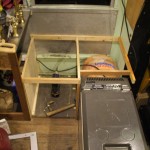
Bulding the platform for wood stove and closet. Note: coolant-/electricity-powered water heater (orange) and solar fridge (grey)
A couple weeks ago I rebuilt a platform I had made for the stove and a closet behind my driver’s seat. Underneath it will be a housed a wood storage bin that doubles as table on wheels – the top of which will be a cutting board that also fits on my sink. Also under the platform is a coolant- and/or electricity-powered marine water heater (soon to be plumbed).
Two months ago in Coos Bay, my friend Ric gave me some leftover zinc from a counter-top, which was plenty to make a barrier for around the wood stove. His friend, Terry, who has helped me with several metal projects, helped shear and break all the zinc so that it could fit some ceiling tiles (recommended by Andrew) for insulating the barrier. The barrier (from stove to wall) is: 1” between the stove and the barrier, the zinc, the ceiling panel, and a ½” air gap. Spacers made from scrap copper pipe hold this 1/2” gap. The stove is bolted through its feet, one of these panels, with a gap, and into the plywood platform. This panel, however, is a piece of stainless from the old back doors of Homegrown Market on Orcas Island.
On the sink side of the woodstove, instead of a gap behind the panel, it is open to under the sink, and above sink level I made a piece of copper sheeting that finished of the backside. It’s decked out with brass hardware and looks pretty snazzy.
The scariest part of the installation was cutting a hole in the ceiling. As Andrew suggested, I held one of the pieces of stovepipe vertical and up to the ceiling and marked out the hole. This helped a lot since a perfect circle for a vertical pipe isn’t a perfect circle on the angled and curved ceiling.

Wood frame and angled bracket to stabilize the double-wall stove pipe as it passed through the roof.
Between the ceiling supports and around the new hole, I build a wood frame to help hold the pipe in place and provide a place to attach the angled stovepipe holder. I had to modify this bracket slightly by bending the edges to make up for the curve of the ceiling. Somehow my calculations ended up a little off and my stovepipe is slightly angled outwards. Oh well. Maybe I’ll fix it someday.
One of the biggest headaches of the process was trying to get the transition piece (from single- to double-wall pipe) to fit in the single-wall pipe. They both had the same diameter and I asked myself if they were even supposed to fit together. I found out that you can crimp pipe like this, so I had it done at the hardware store. It still wouldn’t fit. I had to force it in, which in turn forced the single wall pipe to come apart at the seem. To fix this, I screwed the seam together less than a foot below where the two pieces connected. This kept the seam from coming apart. Once the two pieces were connected, I screwed the seam of the pipe at the top and through the transition piece.
It was here that I also installed the damper. Four-inch dampers are so cute. The screw at the top of the pipe also helps keep the damper in place when in the closed position.
One modification I made to the stove was in the hinges. Originally the stove came with some really cool copper pins for the door hinges. However, these pins seemed too small in diameter to make the door swing nicely and close snugly. In Coos Bay, at Ric’s shop, and with his guidance, I drilled a hole big enough for a ¼” rod in the base casting of the stove directly below the hinges. I took a ¼” brass rod, cut it to length and threaded the ends (with a die). With some finagling, I got the rod through the hole and into the hinges. I capped the top and bottom with some pretty brass acorn nuts. Then I filled the hole I drilled with high temperature cement. The hinge works great, and the accidental benefit of this system is that if you push down on the brass rod it kind of locks the door in place, which is great for keeping it closed for driving and such.
The stovepipe configuration I installed consists of two feet of single wall, two feet of double wall, which goes through the ceiling and ends right around the height of my roof rack. Then there’s a two-foot extension that can be added at anytime (except while driving, obviously). The stove needs at least four feet of pipe, and preferably more for good draft.
The manual for this stove calls for five initial fires, starting small and working up to larger ones. Once I finished the install I started this process with my two-foot extension stovepipe on. These small fires worked great until my third fire when I had a few friends in the bus and it was super windy. I had taken the two-foot extension off, and when a huge gust of wind came a giant puff of smoke came from the stove. Cough, cough. However, when it hasn’t been windy, the stove has worked great without the extension.
I planned on taking off the extension and cap while driving and putting on some kind of cover that sealed on the top of the stovepipe. I had ideas, such as an upside down bucket with a seal and pins to hold it on. Nothing seemed perfect. Instead, I started driving with just the regular stove cap on and the damper closed. No ash has been coming out of the stove and no moisture has come down either, even when driving 60 MPH in dumping rain. I did leave the cap on and damper open one day and quiet a bit of ash blew in while driving. I also bought a four-inch stainless/rubber expandable plug to plug the pipe when I’m not using the stove much (still have to test this). EDIT: Rubber/stainless plug works great, but I haven’t found a need for it yet, except on long hauls, in extreme weather, and when trying to be more incognito (see photos at bottom of post).

Smoke and sparks from the chimney cap. No, there is no flame coming out. It is just lit up by the fire four feet below and accentuated by my slow shutter speed.
From all this, I decided that when I am using the stove a lot, I can drive with the damper shut and regular cap on. I can burn the stove without the extension, unless it’s windy and then I’ll add it. If I’m not using the stove a lot, or will be driving a bunch I will put the four-inch plug in. The extension and cap store nicely in the truck box mounted on my roof. Yay!! I still have to test how the stove works with the extension versus without.
When I first started burning the stove full blast I had problems keeping the fire within reasonable temperatures. I would crank it to 500 degrees and then damper it down and close the flue (like I had been doing since I was a kid). The temps would continue to rise up to over 850 F. This is definitely over-firing the stove. The stove was also burning wood extremely fast. It would be too hot to want to add more wood, and by the time it cooled down enough to want to add wood, the fire would be all but out. I continued having these problems, and even found other people having these issue on the forum for Navigator Stoves. Some people posted ways to make the stove more airtight, and thus more controllable with the flue and damper. In response, Andrew said that because the stove isn’t airtight, and complies with emission standards, it cannot be dampered down like a regular wood stove. And the methods that users were using to create a more airtight stove would actually make it burn less clean (below 250 degrees creates more emissions and creosote).
Yet, when I was pushing my door closed when dampering it down, I found that closing that gap would help keep the fire temps down. Perhaps I should add a piece wood stove gasket material around the door, or seal the little gap below the door as others suggest?

Wood ceiling panels replaced. Notice the partial old Ford headlight rim used as trim at the ceiling.
I realized after a while that much of my problem came from the wood I was burning, which was all scrap from the shop. All of the wood I was putting in was small (2×2 or smaller). Once I started using larger wood (2x4s) my fires responded much better to my attempts to control temps using air control methods. Still, it’s not as good as I’d like. I may still try to seal the door better, or fill the gap below the door. The balance for me is to be able to control the temps without having the fire burning too hot (over 55o degrees F – over-fire) or too cool (under 250 degrees F – creosote buildup and more emissions).
With a stove this small, it’s kind of a bummer, but I’ll never be able to burn it all of the way through the night, as it needs stoking too often. It looks like once it is dialed, my fires will only burn up to 3-4 hours – which is much better than the under-an-hour burn times I was experiencing with smaller wood.
One of the other experiences I’ve been having is that the stove heats the upper half of my bus nicely since it sits at least a foot and a half off the floor. Yet, since it’s tucked back in there so snugly, the floor area by my benches is still kind of cold. Solution: I hope to create a vent at the rear of the stove that connects to a duct under my sink, with a fan that sucks warm air from the stove and pushes it through a vent by the floor by the benches. This fan will also suck air in the same ducting through a small radiator I have that can be powered by coolant (which is heated by my engine or Webasto – a diesel-powered coolant heater that I have). More on this to come.
Sewing my thermal curtains should help with retaining heat as well.
Many people have asked about burning my woodstove while parked on the street. I have mostly been burning it on private property, but the few times I’ve burned it in public I’ve had no problems. I’ve lit it before I went to sleep on a few public, but not well traveled, streets. I’ve also burned it while parked at a couple parks. So far no one has cared. I suspect that there are “open flame” laws that prohibit this, but have yet to get hassled. I am curious though.
All in all, I am so stoked on being warm, just in time for winter. It works great! And it is a fun conversation piece when people come in for tea. People keep commenting on how cozy and nice the bus is getting, and I’m sure the woodstove is a huge part of this.
Whew, that was a slew of words in one sitting. I hope this was interesting to at least one or two of you. If you have any questions, please feel free to contact me. For more information on Navigator Stoves, please visit their website or their forum.
Coming soon: running water!


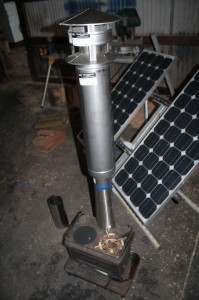

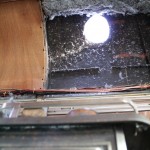


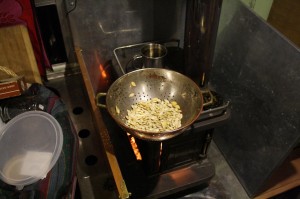

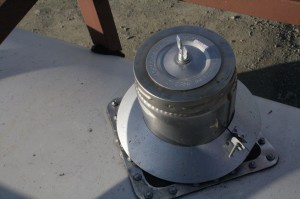


27 Responses to Little Cod Wood Stove – Bus Building